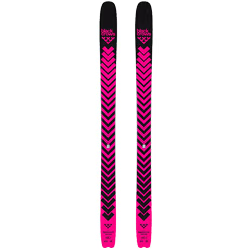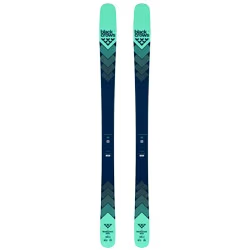Skis Black Crows
(9)Guide to the Right Skis
Thinking of buying new skis but not completely sure which ones are right for you? Read the tips below and we’re confident you’ll quickly find the right match.
Read more-
Black Crows Skis Atris Birdie 105 2026 women'sPrice:749,95€
-
-
-
Black Crows Skis Corvus Freebird 107 2026Price:999,95€
-
-
Black Crows Skis Navis Freebird 102 2026Price:899,95€
-
Black Crows Skis Orb Freebird 2026Price:759,95€
-
Black Crows Skis Camox Freebird 95 2026Price:799,95€
When choosing the right skis, you should first ask yourself what kind of terrain you will ski on most often. Do you enjoy carving turns on groomed slopes, long turns in fresh powder, jumps and tricks in the park, or do you prefer climbing the mountain with skis on your feet and skiing down your own line?
To make the choice easier, we have divided skis into several categories according to their purpose:
-
All-round skis: most skiers will choose these skis. Their main characteristic is that they allow safe and enjoyable skiing on groomed slopes all day long.
In this category you will find skis suitable for complete beginners as well as expert skiers. If you are a beginner, we recommend slightly shorter skis (approx. 10–15 cm below your body height), narrower and softer. Such skis are easier to control and forgive beginner mistakes.
More advanced skiers will choose longer skis (5–10 cm below their body height), stiffer and somewhat wider. These skis provide complete control even at high speeds, but require a stronger and more aggressive skier.
In recent years, from more “freeski”-oriented countries such as the USA and Canada, and in Europe France, a trend of slightly wider all-round skis has arrived. Manufacturers have adapted these skis to the Central European market (widths 78–86 mm), still combining most of the advantages of classic alpine skis – good edge grip, torsional stability, liveliness… Thanks to the additional width, these skis are especially useful when slope conditions are not ideal: fresh, soft snow, spring conditions, forgiving more mistakes and giving the skier more reaction time. Despite all these advantages, they still offer excellent grip even on morning “ice” or freshly groomed runs. -
Women’s All-round skis: women’s all-round skis are designed for skiing on groomed slopes. Compared to men’s, they differ mainly in stiffness, being somewhat softer, and in geometry, which is slightly less aggressive than men’s models.
Since we know that aesthetics are also important to women, women’s skis are usually color-coordinated with ski boots and ski outfits.
Beginners should choose slightly shorter skis, 10–15 cm below their height, as they are more maneuverable.
More advanced female skiers and speed enthusiasts should choose skis 5–10 cm shorter than their height. -
Racing skis: for very good recreational and expert skiers, we recommend racing skis. These skis hide top technologies also used by World Cup racers. They are stiff and aggressive, requiring a lot of knowledge and good physical condition.
Racing skis are generally divided into slalom and giant slalom. If you enjoy short and aggressive turns, then slalom skis are what you need. Their turning radius ranges from 11 to 13 m.
Giant slalom skis are the choice if you attack the slope in long arcs at the highest speeds. Their radius is between 17 and 20 m. Slalom skis should be 15–20 cm shorter than your height, while giant slalom skis should be as long as you are tall or even a few cm longer. -
Freestyle skis: skis for all freestyle skiers. Jumps, rails, boxes, halfpipes, parks, or street spots are where freestyle skis feel at home.
Their main feature is that both tip and tail are equally upturned (allowing skiing backward), and bindings are mounted in the exact center of the ski. They are designed for tricks and acrobatic jumps.
Length choice depends on your skill: if you are inexperienced, we recommend skis about 10 cm shorter than your height. If you are already an experienced freestyler, choose skis as long as your height, as they will be more stable and allow safer landings. -
Freeride skis: skis designed for skiing off-piste. Perfect on wide powder fields, cliff drops, steep couloirs...
-
Touring skis: if you love hiking up snowy mountains, you need touring skis. Their main features are lower weight, good float, and solid performance on all types of snow.
Touring skis have also become somewhat wider recently (90–100 mm underfoot) and use various rockers for better float. Wider, longer, and stiffer skis are suitable for experienced ski tourers.
For beginners, we recommend slightly narrower and shorter skis, usually about 10 cm below height. Touring skis must be combined with proper touring bindings and climbing skins for uphill travel. -
Kids’ skis: designed for young skiers, from beginners to those already racing down snowy slopes.











